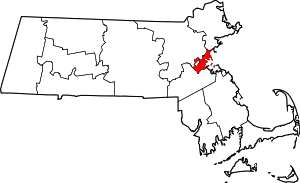Winthrop, Massachusetts
Winthrop is a city in Suffolk County, Massachusetts, United States. The population was 17,497 at the 2010 census and as of 2019 the population has grown to an estimated 18,544.[3] Winthrop is an ocean-side suburban community in Greater Boston situated at the north entrance to Boston Harbor, close to Logan International Airport. It is located on a peninsula, 1.6 square miles (4.2 km2) in area, connected to Revere by a narrow isthmus and to East Boston by a bridge over the harbor inlet to the Belle Isle Marsh Reservation. Settled in 1630, Winthrop is one of the oldest communities in the United States. It is also one of the smallest and most densely populated municipalities in Massachusetts. It is one of the four cities that comprise Suffolk County (the others are Boston, Revere, and Chelsea). It is the southernmost part of the North Shore, with a 7-mile (11 km) shoreline that provides views of the Atlantic Ocean to the east and of the Boston skyline to the west.
Winthrop, Massachusetts | |
|---|---|
 | |
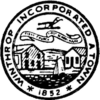 Seal | |
| Nickname(s): Winthrop-by-the-Sea | |
| Motto(s): "Where the North Shore begins" | |
 Location in Suffolk County and the state of Massachusetts | |
 Winthrop, Massachusetts Location in the United States | |
| Coordinates: 42°22′30″N 70°59′00″W | |
| Country | United States |
| State | Massachusetts |
| County | Suffolk |
| Settled | 1630 |
| Incorporated | 1852 |
| Government | |
| • Type | Council-manager |
| • Council President | Philip Boncore |
| • Town Manager | Austin Faison |
| Area | |
| • Total | 8.32 sq mi (21.55 km2) |
| • Land | 1.99 sq mi (5.16 km2) |
| • Water | 6.33 sq mi (16.39 km2) |
| Elevation | 36 ft (11 m) |
| Population (2010) | |
| • Total | 17,497 |
| • Estimate (2019)[2] | 18,544 |
| • Density | 9,318.59/sq mi (3,597.03/km2) |
| Time zone | UTC-5 (Eastern) |
| • Summer (DST) | UTC-4 (Eastern) |
| Zip code | 02152 |
| Area code(s) | 617 / 857 |
| FIPS code | 25-80930 |
| GNIS feature ID | 0618335 |
| Website | www.town.winthrop.ma.us |
In 2005, the Town of Winthrop voted to change its governance from a representative town meeting adopted in 1920 to a council-manager form of government. Under Massachusetts law, as of 2006 when the new Town Charter took effect, Winthrop became de jure a city. However, it is one of thirteen cities in Massachusetts that chose to remain known as a 'town.'[4]
History
Winthrop was settled in 1630 by English Puritan colonists as Pullen Poynt (Pulling Point), so named because the tides made hard pulling for boatmen.[5][6] The present town is named after John Winthrop (1587–1649), second governor of the Massachusetts Bay Colony and an English Puritan leader. On April 8, 1630, Winthrop departed from the Isle of Wight, England on the ship Arbella, arriving in Salem in June where he was met by John Endecott, the first governor of the colony. John Winthrop served as governor for twelve of the colony's first twenty years of existence. It was he who decided to base the colony at the Shawmut Peninsula, where he and other colonists founded what is now the City of Boston.
Originally part of an area called Winnisimmet by the native Massachusett tribe,[7] Pullen Poynt was annexed by the Town of Boston in 1632 and was used as a grazing area. In 1637, it was divided into fifteen parcels of land that were given by Governor Winthrop to prominent men in Boston with the stipulation that each must erect a building on his land within two years. Few, if any, of these men ever lived on these parcels of land, but their farms prospered. One of these early houses, the Deane Winthrop House, was the home of Governor Winthrop's youngest son, Deane Winthrop, who lived there until his death in 1704. This house is still standing and is also the oldest continually occupied home in the United States. Although occupied, it is also open to the public at select times. The house is maintained by the Winthrop Improvement and Historical Association.[8]
In 1739, what is now Chelsea, Revere, and Winthrop, withdrew from Boston due to governmental control disputes and became the Town of Chelsea. In 1775, residents of the Town of Chelsea played a key role in the Battle of Chelsea Creek of the American Revolutionary War.[9] Again, the desire for more local control resulted in Revere and Winthrop seceding from Chelsea in 1846 to become North Chelsea. Shortly thereafter, in 1852, Winthrop was incorporated as a town in its own right with a Board of Selectmen and Open Town Meeting form of government. In 1920, Winthrop was the second town in the Commonwealth of Massachusetts to apply for and receive a Charter for a Representative Town Meeting, which continued to 2006.
As noted above, Winthrop adopted a home rule charter in 2005 with a council-manager form of government[10][11] and is no longer governed by a representative town meeting. It is now legally a city, but chooses to be known as a town that has a city form of government.[12][13] The new Town Charter, which took effect in 2006, was passed in a special election. The Board of Selectmen and Town Meeting were abolished, and legislative powers were vested in an elected Town Council. Executive power, largely ceremonial, resides in the Council President, who is popularly elected. An appointed Town Manager serves as the head of administrative services.
Geography and transportation


According to the United States Census Bureau, the town has a total area of 8.3 square miles (21.5 km2), of which 2.0 square miles (5.2 km2) is land and 6.3 square miles (16.3 km2) (76.02%) is water. However, according to the Town Government, Winthrop has a land area of just 1.6 square miles (4.1 km2).
Winthrop is connected by land skirting the Belle Isle Marsh Reservation, which is shared across the Belle Isle Inlet with East Boston. The town was originally separated from Deer Island. Although still an island by name, Deer Island has been connected to Winthrop since the former Shirley Gut channel, which once separated the island from the town, was filled in by the New England Hurricane of 1938. The town is considered the northern dividing line between Boston Harbor to its west and Massachusetts Bay to its east.
The town is divided into several neighborhoods with a central downtown area, including Court Park and Cottage Park along the Boston Harbor side of town, and Point Shirley, Cottage Hill, Winthrop Beach, Ocean Spray, and Winthrop Highlands on the Massachusetts Bay side. The town is bordered by Revere to the north, and Boston on the northwest, west, and southeast. The water rights of the town extend to the edge of the county, and border those of Nahant in Essex County. As a result of the expansion of Logan International Airport, part of four of the runways (4L/22R, 4R/22L, 15R/33L, and most of 15L/33R) lies within what was once the water rights of the town. By land, Winthrop is 5.5 miles (8.9 km) from Beacon Hill, the measuring point for all road signs in Massachusetts.
Deer Island, though within the city limits of Boston, is located in Winthrop Bay. It ceased to be an island in the 1930s when Shirley Gut, which separated it from Winthrop, was filled in. The island has a sordid past as an internment camp for Native Americans during King Philip's War, a quarantine station where many immigrants died, and the site of a county jail. Today, the island is home to the mammoth Deer Island Waste Water Treatment Plant, which provides sewage treatment for the Boston area.[14] In spite of the presence of the water treatment plant, Deer Island has been part of the Boston Harbor Islands National Recreation Area since 1996 and the remainder of the island consists of park land and offers walking, jogging, sightseeing, picnicking, and fishing. Part of the park land consists of a man-made earthen berm that partly conceals the treatment plant from view from Winthrop. The island is now popular with many Winthrop residents, due to the park landscaping and views of Boston Harbor and the Atlantic Ocean.
Massachusetts Route 145 passes through the town as its only state route and the only connection to the mainland (via Main Street and Winthrop Parkway at opposite ends of town). It enters from the Orient Heights neighborhood of East Boston then passes in a loop around the main body of the town (bypassing Cottage Hill and Point Shirley) before leaving the town to the north, turning into the Winthrop Parkway in Revere. Two bus routes are provided by Paul Revere Transportation, which run from Point Shirley through the highlands and center of the town and terminate at Orient Heights. Paul Revere Transportation has operated the bus service in town since 1991. The service, which is subsidized by the MBTA, operates as Route 712 Point Shirley or Winthrop Beach to Orient Heights Station via Winthrop Highlands and Route 713 Point Shirley or Winthrop Beach to Orient Heights via Winthrop Center.[15] Prior to this, the service was operated by Rapid Transit, which began bus service in Winthrop on January 28, 1940, the day immediately following the closure of the Boston, Revere Beach and Lynn Railroad (known as the "Narrow Gauge") which had a Winthrop Branch (1877-1940) with nine stations. The Blue Line of the MBTA subway system crosses near the town, with stops at Orient Heights Station, Suffolk Downs Station, and Beachmont Station, all of which are just a half mile from the city limits. A water transportation dock is located at the public landing and provides ferry service across Boston Harbor. Currently, Boston Harbor Cruises operates the service seasonally (May through October) between Winthrop and Rowes Wharf.[16]
Demographics
| Year | Pop. | ±% |
|---|---|---|
| 1860 | 544 | — |
| 1870 | 532 | −2.2% |
| 1880 | 1,043 | +96.1% |
| 1890 | 2,726 | +161.4% |
| 1900 | 6,058 | +122.2% |
| 1910 | 10,132 | +67.2% |
| 1920 | 15,455 | +52.5% |
| 1930 | 16,852 | +9.0% |
| 1940 | 16,768 | −0.5% |
| 1950 | 19,496 | +16.3% |
| 1960 | 20,303 | +4.1% |
| 1970 | 20,335 | +0.2% |
| 1980 | 19,294 | −5.1% |
| 1990 | 18,127 | −6.0% |
| 2000 | 18,303 | +1.0% |
| 2010 | 17,497 | −4.4% |
| 2019 | 18,544 | +6.0% |
| * = population estimate. Source: United States Census records and Population Estimates Program data.[17][18][19][20][21][22][23][24][25][26] Source: | ||
As of the census[28] of 2000, there were 18,303 people, 7,843 households, and 4,580 families residing in the town. The population density was 9,208 people per square mile (3,551.2/km2). There were 8,067 housing units at an average density of 4,058.5 per square mile (1,565.2/km2). The racial makeup of the town was 94.44% White, 1.68% Black, 1.15% Asian, 0.16% Native American, 0.04% Pacific Islander, 1.36% from other races, and 1.16% of two or more races. Hispanic or Latino people of any race comprised 2.69% of the population.
There were 7,843 households, of which 23.6% had children under the age of 18 living with them, 43.1% were married couples living together, 11.5% had a female householder with no husband present, and 41.6% were non-families. 32.5% of all households were made up of individuals, and 11.9% had someone living alone who was 65 years of age or older. The average household size was 2.3 and the average family size was 2.98.
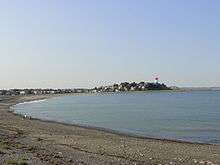
In the town the population was spread out, with 18.6% under the age of 18, 7.3% from 18 to 24, 33.2% from 25 to 44, 24.4% from 45 to 64, and 16.5% who were 65 years of age or older. The median age was 40 years. For every 100 females, there were 88.8 males. For every 100 females age 18 and over, there were 86.3 males.
The median income for a household in the town was $53,122, and the median income for a family was $65,696. Males had a median income of $42,135 versus $36,298 for females. The per capita income for the town was $27,374. About 3.3% of families and 5.5% of the population were below the poverty line, including 4.1% of those under age 18 and 8.0% of those age 65 or over.
Local businesses and utilities
By the mid-1990s, large shopping malls in the nearby North Shore region of Massachusetts, especially Square One Mall in Saugus, began to drain small businesses, though a strong small business community still prevails.
Located on Great Head (Water Tower Hill) is the Winthrop Water Tower. It is a red, white, and blue striped tower capable of holding 1 million US gallons (3,800 m3) of water. It is maintained by Winthrop's Water Department.[29]
The town is divided into four unique business areas: the Shirley Street Business District, the Highlands District, the Center, and Magee's Corner District. In July 2017, Massachusetts Governor Charlie Baker announced a $2.38 million grant to the town to redevelop its Centre Business District.[30]
Winthrop has a weekly newspaper, the Winthrop Sun Transcript, which reports local news, current events, happenings, and town concerns.
Education
Winthrop currently has four schools that are a part of Winthrop Public Schools:
- Winthrop Middle School, grades 6-8
- Winthrop High School, grades 9-12
- Arthur T. Cummings Elementary School, grades 3–5
- William P. Gorman Fort Banks Elementary School, grades PK-2
Note: Winthrop Middle School and Winthrop High School are housed in the same building, but are two separate and distinct schools with their own administration.
Religion
Winthrop has several places of worship for various denominations. They include:
- Community Christian Center[31]
- Congregation Tifereth Abraham[32]
- First Church, United Methodist[33]
- Holy Rosary Catholic Church[34]
- St. John the Evangelist Catholic Church[35]
- St. John's Episcopal Parish[36]
- Temple Tifereth Israel[37]
- Harbor City Church[38]
Most Winthrop residents belong to various Christian denominations, such as Roman Catholicism, Methodism, and Episcopalianism. Adherents of Judaism make up a small, but historically significant, minority. Over the past four decades, the once large Jewish community has dwindled due to frequent migration to other parts of Massachusetts.
Points of interest
Beaches
Winthrop has numerous beaches due to being surrounded by water. The major beaches are Winthrop Beach and Yirrell Beach; others include Donovan's Beach, Halford Beach, Pico Beach and Short Beach.
Military forts
Winthrop is home to two historic military forts, Fort Banks and Fort Heath. Fort Banks was a United States Coast Artillery fort, which served to defend Boston Harbor from enemy attack from the sea and was built in the 1890s during what is known as the Endicott period, a time in which the coast defenses of the United States were seriously expanded and upgraded with new technology. Fort Heath was built in 1898 also as a Coast Artillery fort. It is now replaced with the Fort Heath Apartment building, Seal Harbor condominia, and a small park on the bluff overlooking the Atlantic Ocean and Revere Beach.
Historic places
Winthrop has five places on the National Register of Historic Places.
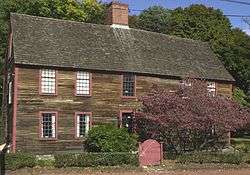

 Fort Banks Mortar Battery
Fort Banks Mortar Battery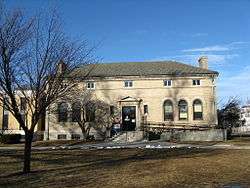 Winthrop Center/Metcalf Square Historic District
Winthrop Center/Metcalf Square Historic District
Recreation
Among numerous baseball fields and recreational parks, Winthrop's recreational facilities include Larsen Rink, an indoor ice skating rink, and Winthrop Golf Course, a private 9-hole, par 35 golf course.
Notable people
See also Category:People from Winthrop, Massachusetts.
- Don and Richard Addrisi, singing-songwriting duo[39][40]
- Mark Bavaro, former National Football League player
- Herbert Bix, Pulitzer Prize winning author
- Patricia Brown, All-American Girls Professional Baseball League player
- Robert DeLeo, politician and Speaker of the Massachusetts House of Representatives
- Rick DiPietro, former National Hockey League goalie
- Art Ditmar, former Major League Baseball player
- Terry Driscoll, professional basketball player
- Gaylord DuBois, author
- Dale Dunbar, former National Hockey League defenseman
- Mike Eruzione, former ice hockey player and captain of the 1980 Winter Olympics United States national team in the famous Miracle on Ice game
- Lewis P. Fickett Jr., Virginia state legislator, diplomat, and educator
- Irving Fine, composer, member of the Boston School[41]
- Stanley Forman, photojournalist
- Thomas Fulham, President of Suffolk University from 1970–1980
- Michael Goulian, aerobatic pilot
- Bob Hansen, Major League Baseball player for the Milwaukee Brewers
- Marie Jansen, musical actress, long-time resident
- Edward J. King, Governor of Massachusetts (1979–1983)
- James M. Matarazzo, academic
- Robert Ellis Orrall, singer-songwriter
- Sylvia Plath, poet
- Lauren Rikleen, author, lawyer, workplace expert
- Unearth, metalcore band
- Steven Van Zandt, musician for Bruce Springsteen's E Street Band
- Bob Walsh, former National Basketball Association executive
- Benjamin Lee Whorf, linguist
- Richard Whorf, actor
- Pat Woodell, actress and singer
References
- "2019 U.S. Gazetteer Files". United States Census Bureau. Retrieved July 25, 2020.
- "Population and Housing Unit Estimates". United States Census Bureau. May 24, 2020. Retrieved May 27, 2020.
- Bureau, U. S. Census. "U.S. Census website". United States Census Bureau. Retrieved 2020-03-31.
- . Secretary of the Commonwealth of Massachusetts. Retrieved on 2013-25-12.
- Town of Winthrop, MA - About Winthrop Archived 2014-12-24 at the Wayback Machine. Town.winthrop.ma.us (2007-08-20). Retrieved on 2013-09-18.
- Hall, Charles W. (1902). "Historic Winthrop, 1630-1902". Retrieved 31 December 2013.
- Massachuset. Dickshovel.com. Retrieved on 2013-09-18.
- Winthrop Improvement and Historical Association
- "Archived copy". Archived from the original on 2009-09-29. Retrieved 2009-06-29.CS1 maint: archived copy as title (link)
- "Town of Winthrop – Town Charter". Archived from the original on 2014-10-31. Retrieved 2006-04-26.
- "Town of Winthrop – Winthrop's form of government" (PDF). Archived from the original (PDF) on 2011-07-21. Retrieved 2009-03-03.
- MassGIS Towns Data Layer
- "Massachusetts Municipal Association". Archived from the original on 2013-06-15. Retrieved 2010-09-30.
- "Deer Island Factsheet". Boston Harbor Islands Partnership. Archived from the original on June 29, 2006. Retrieved August 21, 2006.
- > Schedules & Maps > Private Bus. MBTA. Retrieved on 2013-09-18.
- Archived October 7, 2011, at the Wayback Machine
- "Total Population (P1), 2010 Census Summary File 1". American FactFinder, All County Subdivisions within Massachusetts. United States Census Bureau. 2010.
- "Massachusetts by Place and County Subdivision - GCT-T1. Population Estimates". United States Census Bureau. Retrieved July 12, 2011.
- "1990 Census of Population, General Population Characteristics: Massachusetts" (PDF). US Census Bureau. December 1990. Table 76: General Characteristics of Persons, Households, and Families: 1990. 1990 CP-1-23. Retrieved July 12, 2011.
- "1980 Census of the Population, Number of Inhabitants: Massachusetts" (PDF). US Census Bureau. December 1981. Table 4. Populations of County Subdivisions: 1960 to 1980. PC80-1-A23. Retrieved July 12, 2011.
- "1950 Census of Population" (PDF). Bureau of the Census. 1952. Section 6, Pages 21-10 and 21-11, Massachusetts Table 6. Population of Counties by Minor Civil Divisions: 1930 to 1950. Retrieved July 12, 2011.
- "1920 Census of Population" (PDF). Bureau of the Census. Number of Inhabitants, by Counties and Minor Civil Divisions. Pages 21-5 through 21-7. Massachusetts Table 2. Population of Counties by Minor Civil Divisions: 1920, 1910, and 1920. Retrieved July 12, 2011.
- "1890 Census of the Population" (PDF). Department of the Interior, Census Office. Pages 179 through 182. Massachusetts Table 5. Population of States and Territories by Minor Civil Divisions: 1880 and 1890. Retrieved July 12, 2011.
- "1870 Census of the Population" (PDF). Department of the Interior, Census Office. 1872. Pages 217 through 220. Table IX. Population of Minor Civil Divisions, &c. Massachusetts. Retrieved July 12, 2011.
- "1860 Census" (PDF). Department of the Interior, Census Office. 1864. Pages 220 through 226. State of Massachusetts Table No. 3. Populations of Cities, Towns, &c. Retrieved July 12, 2011.
- "1850 Census" (PDF). Department of the Interior, Census Office. 1854. Pages 338 through 393. Populations of Cities, Towns, &c. Retrieved July 12, 2011.
- "Census of Population and Housing". Census.gov. Retrieved June 4, 2016.
- "U.S. Census website". United States Census Bureau. Retrieved 2008-01-31.
- Archived April 1, 2010, at the Wayback Machine
- "Baker-Polito Administration Awards $2.38 Million to Support Winthrop's Centre Business District". www.mass.gov. July 21, 2017. Retrieved July 11, 2018.
- Community Christian Church of Winthrop Archived 2012-03-26 at the Wayback Machine. Kingdomspirit.tv. Retrieved on 2013-09-18.
- Congregation Tifereth Abraham | Jewish Boston Resources Archived 2010-12-02 at the Wayback Machine. Jewishboston.com. Retrieved on 2013-09-18.
- First Church of Winthrop, United Methodist Archived 2010-01-15 at the Wayback Machine. Gbgm-umc.org. Retrieved on 2013-09-18.
- Holy Rosary Catholic Parish. Holyrosaryparish.net. Retrieved on 2013-09-18.
- St. John the Evangelist Church | An Archdiocese of Boston Parish in Winthrop, MA. Stjohnswinthrop.org (2013-08-13). Retrieved on 2013-09-18.
- Home. Stjohnsepiscopal-winthropma.org. Retrieved on 2013-09-18.
- Welcome to Temple Tifereth Israel of Winthrop, Massachusetts Archived 2009-12-23 at the Wayback Machine. Jewishwinthrop.org (2013-09-01). Retrieved on 2013-09-18.
- Harbor City Church of Winthrop, Massachusetts. harborcitychurch.net
- "Richard Addrisi: "Never My Love" - The Katz Tapes". The Katz Tapes. Retrieved 2016-03-11.
- "Addrisi Brothers". Discogs. Retrieved 2016-03-11.
- http://www.sequenza21.com/2014/05/about-irving-fine-twelve-tone-music-and-bmops-a-fine-centennial/
External links
| Wikimedia Commons has media related to Winthrop, Massachusetts. |
- Official website
- Winthrop Chamber of Commerce
- Discover Winthrop
- Winthrop Improvement and Historical Association
Are you interested in Moving to Winthrop, Massachusetts?
